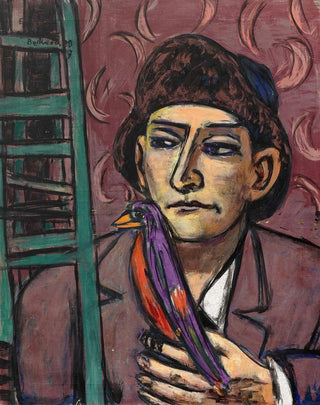Art print | Man with Bird - Max Beckmann


View from behind

Frame (optional)
Max Beckmann's "Man with Bird" is part of a rich and complex artistic universe, where the dialogue between man and nature is poignantly established. This painting, emblematic of the expressionist style, evokes intense emotions while inviting reflection on the human condition. Through this artwork, Beckmann explores themes of isolation and the search for identity, revealing a psychological depth that captivates the viewer. The presence of the bird, a symbol of freedom and escape, contrasts with the posture of the figure, suggesting a tug-of-war between the aspiration for lightness and the weight of earthly realities. This piece is much more than a simple representation; it is an invitation to delve into the human soul.
Style and uniqueness of the artwork
Beckmann's style is distinguished by his bold use of colors and shapes, creating a visual universe that is both unsettling and fascinating. In "Man with Bird," dark hues, mixed with flashes of light, enhance the dramatic atmosphere of the scene. The figure, with its defined features and penetrating gaze, seems to bear the weight of a personal story, while the bird, perched on his arm, adds a touch of mystery and poetry. Angular lines and asymmetrical compositions, characteristic of Beckmann's work, contribute to a visual dynamic that captures attention. The artwork invites deep contemplation and immersion into a world where every detail matters, where each brushstroke tells a story.
The artist and his influence
Max Beckmann, a major figure of German expressionism, knew how to leave his mark on his era through an innovative approach to art. Born in 1884 in Leipzig, he navigated the tumult of his time, including the two world wars, which profoundly influenced his work. Beckmann always sought to express the complexity of human experience, blending references to mythology, literature, and history. His style, both personal and universal, has inspired many artists and continues to influence current generations. Through works like "H

Matte finish

View from behind

Frame (optional)
Max Beckmann's "Man with Bird" is part of a rich and complex artistic universe, where the dialogue between man and nature is poignantly established. This painting, emblematic of the expressionist style, evokes intense emotions while inviting reflection on the human condition. Through this artwork, Beckmann explores themes of isolation and the search for identity, revealing a psychological depth that captivates the viewer. The presence of the bird, a symbol of freedom and escape, contrasts with the posture of the figure, suggesting a tug-of-war between the aspiration for lightness and the weight of earthly realities. This piece is much more than a simple representation; it is an invitation to delve into the human soul.
Style and uniqueness of the artwork
Beckmann's style is distinguished by his bold use of colors and shapes, creating a visual universe that is both unsettling and fascinating. In "Man with Bird," dark hues, mixed with flashes of light, enhance the dramatic atmosphere of the scene. The figure, with its defined features and penetrating gaze, seems to bear the weight of a personal story, while the bird, perched on his arm, adds a touch of mystery and poetry. Angular lines and asymmetrical compositions, characteristic of Beckmann's work, contribute to a visual dynamic that captures attention. The artwork invites deep contemplation and immersion into a world where every detail matters, where each brushstroke tells a story.
The artist and his influence
Max Beckmann, a major figure of German expressionism, knew how to leave his mark on his era through an innovative approach to art. Born in 1884 in Leipzig, he navigated the tumult of his time, including the two world wars, which profoundly influenced his work. Beckmann always sought to express the complexity of human experience, blending references to mythology, literature, and history. His style, both personal and universal, has inspired many artists and continues to influence current generations. Through works like "H






